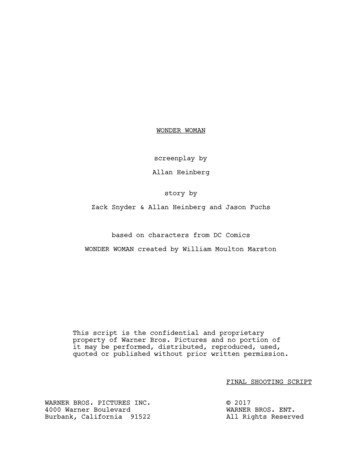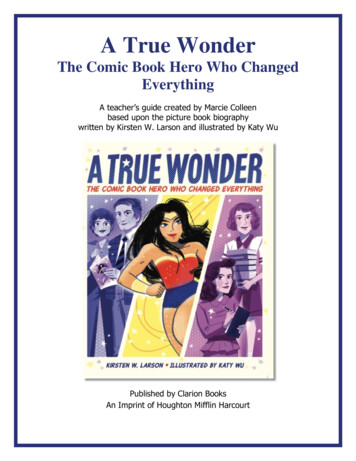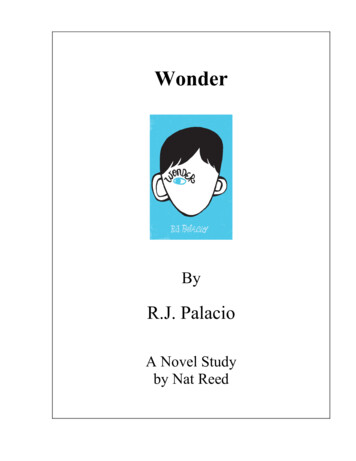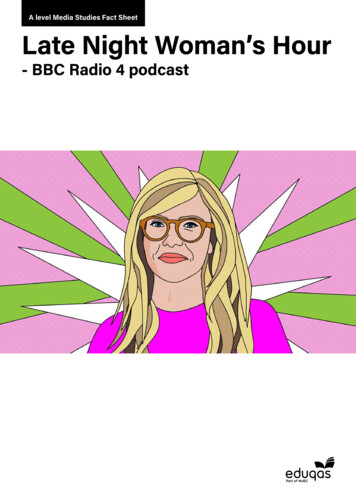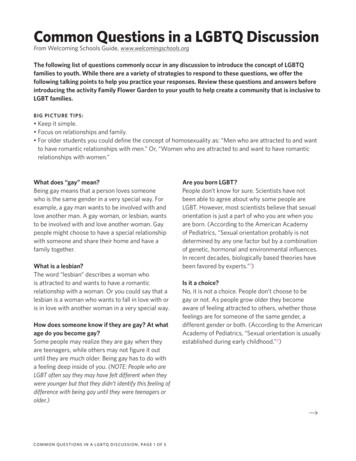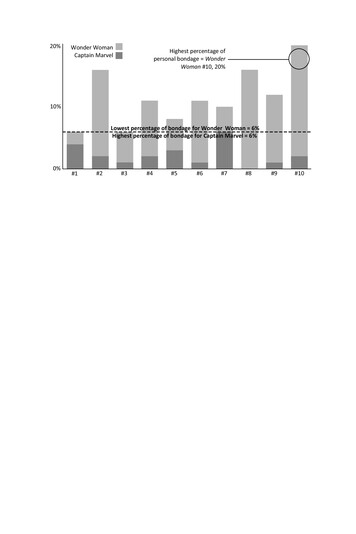
Transcription
20%Wonder WomanCaptain MarvelHighest percentage ofpersonal bondage #10, 20%10%Lowest percentage of bondage for Wonder Woman 6%Highest percentage of bondage for Captain Marvel 6%0%#1#2#3#4#5#6#7#8#9#10
40% Highest percentage ofoverall bondage #4, 41%20% 0%#1#2#3#4#5 #6#7#8#9#10
An interpretation of thebrank, neck collar, legmanacles, chains, andinterwoven lasso on afemale form. KATE LETH
100%1942: TheHolliday Girlsfirst appear1948: Kanighertakes over 1965-67: Kanighersets in the Golden Age1960-62:Kanigher bringsback theHolliday Girls; itdoesn't last1954-55: published, CCAbegins0%19451950195519601965
1942: First appearanceof the Amazons100%1955: The ComicsCode Authority isimplemented1958: Kanigher's newdirection for begins1948: Kanighertakes over 0%19451950195519601965
April 1955: #73 is the first issue of theseries to bear the CCA's sealSpring 1954: published15%October 1955: Last issueof withover 5% bondage10%May 1958:Kanigher's newdirection for theseries beginswith #985%0%556065707580859095100
90%1962: Highestpercentage of femaleletter writers 89%1972: Lowestpercentage of femaleletter writers 15%50%10%196119681975
No 1961:ads for girls. ! " BoysNeutral Girls !#
30%Highest overall bondage,"When Treachery Wore aGreen Shirt" 32%Highest Wonder Womanbondage, "The MysteriousPrisoners of Anglonia" 26%Wonder WomanBondageOverall Bondage20%10%0%36912
1990Wonder Woman, 1987-2011Detective Comics, 1987-20111987Azrael: Agent of the Bat, 1995-2003Superman: Man of Steel, 1991-2003Supergirl, 1996-2003Superboy and the Ravers, 1996-1998Steel, 1994-1998Superboy, 1994-20021993Robin, 1993-20091999Nightwing, 1996-20091996Catwoman, 1993-2001Batman: Legends of the Dark Knight, 1989-2007Batman: Shadow of the Bat, 1992-2000Batman, 1987-2011Superman, 1987-2011Adventures of Superman, 1987-2006Action Comics, 1987-20112002Catwoman, 2002-2008Batman: Gotham Knights, 2000-2006Batgirl, 2000-20062005Batgirl, 2009-201120082011Batman: Streets of Gotham, 2009-2011Batman and Robin, 2009-2011Batman Confidential, 2007-2011Superman/Batman, 2003-2011Superman Confidential, 2007-2008Supergirl, 2005-2011Superboy, 2011
TOP LEFT: All Star Comics #8, cover byEverett E. Hibbard, All-American Comics,1941The first appearance of Wonder Woman,though she’s not on the cover. She continuedto costar in All Star Comics as the secretaryof the Justice Society.TOP RIGHT: Sensation Comics #1, coverby H. G. Peter, All-American Comics, 1942Wonder Woman’s origin story continuedhere, launching her new series. WonderWoman starred in the lead story and on thecover of Sensation Comics every month.BOTTOM RIGHT: Wonder Woman #1,cover by H. G. Peter, All-AmericanComics, 1942Wonder Woman’s solo series. She starredin every story in each issue, which came outquarterly during the Golden Age.
TOP LEFT: Action Comics #1, cover byJoe Shuster, Detective Comics Inc., 1938The first appearance of Superman, thehero who started the superhero craze.Many imitators followed, which led WilliamMoulton Marston to create Wonder Womanas a counter to the genre’s “blood-curdlingmasculinity.”TOP RIGHT: Captain America Comics #1,cover by Jack Kirby, Timely Comics, 1941The first appearance of Captain America,an American super soldier, punching Hitlerbefore America even entered World War II.BOTTOM LEFT: Whiz Comics #2, cover byC. C. Beck, Fawcett Comics, 1940The first appearance of Captain Marvel.He was less violent than other heroes butenjoyed demonstrating his superior strength,while Wonder Woman only used force as alast resort.
TOP: Wonder Woman sketch by H. G. Peter, 1941An original design of the character, with notes by Marston and Peter. The skirt was soonreplaced by briefs, and the sandals became boots. H. G. PETER; IMAGE COURTESY OF HERITAGEAUCTIONS (WWW.HA.COM)BOTTOM: Etta Candy vs. the Cheetah sketch by H. G. Peter, 1943Etta Candy, the stalwart leader of the Holliday Girls, boxes with the felonious Cheetah.H. G. PETER; IMAGE COURTESY OF HERITAGE AUCTIONS (WWW.HA.COM)
LEFT: The Wonder Womanteam, from Wonder Woman#2, All-America Comics, 1942From left to right, writer WilliamMoulton Marston, artist H. G.Peter, editor Sheldon Mayer,and publisher Max Gaines.BOTTOM: The Marstons andfriends at home, 1944From left to right, Marston’slive-in lover Olive Byrne (notethe large bracelets), occasionalWonder Woman writer JoyeMurchison, Marston’s wifeElizabeth Holloway Marston,and Marston himself. IMAGECOURTESY OF PETE AND CHRISTIEMARSTON
Ad for Gillette razors, LIFE magazine, October 24, 1938Marston shows how the lie detector proves Gillette’s superiority. Though a Harvard-educatedpsychologist, Marston was a bit of a huckster as well.
LEFT: Alice Marble, from WonderWoman #1, All-American Comics, 1942The former tennis star and associateeditor of Wonder Woman, enjoying theseries’ first issue. Marble worked onsixteen issues of the series and wrotethe regular “Wonder Women of History”feature.BOTTOM LEFT: Sensation Comics #13,cover by H. G. Peter, DC Comics, 1943Wonder Woman strikes against Hitler,Hirohito, and Mussolini in this wartimeissue.BOTTOM RIGHT: Wonder Woman #10,cover by H. G. Peter, DC Comics, 1944Wonder Woman halts an alien invasion,ultimately ending the conflict bynegotiating a trade agreement betweenEarth and Saturn.
RIGHT: Venus with Us by WilliamMoulton Marston, Sears Publishing,1932The classier, original cover for Marston’ssex romp novel about Julius Caesar.IMAGE COURTESY OF THE BOOK COLLECTOR’SLIBRARY (WWW.TBCLRAREBOOKS.COM)BOTTOM: The Private Life of JuliusCaesar by William Moulton Marston,Universal, 1952Venus with Us retitled and recovered asa pulp novel featuring scores of nudewomen to better reflect the lasciviousstory inside. IMAGE COURTESY OF HANG FIREBOOKS (WWW.HANGFIREBOOKS.COM)
TOP LEFT: Wonder Woman #103, coverby Ross Andru and Mike Espositio, DCComics, 1959New artists updated Wonder Woman’slook in the Silver Age, replacing Peter’sclassic style with a more conventionalaesthetic and a tweaked costume design.TOP RIGHT: Crime SuspenStories #22,cover by Johnny Craig, EC Comics,1954The cover that doomed WilliamGaines’s testimony before the SenateSubcommittee on Juvenile Delinquencywhen he had to declare that it was “ingood taste.”BOTTOM LEFT: The seal of the ComicsCode AuthorityThe mark of the organization thatmonitored comic book content fordecades.
TOP LEFT: Justice League of America #1,cover by Murphy Anderson, DC Comics,1960For a decade, Wonder Woman was the onlyfemale member of DC’s superhero team—now a full member and not just the secretary.TOP RIGHT: Wonder Woman #105,cover by Ross Andru and Mike Esposito,DC Comics, 1959Robert Kanigher loved fantastical creatures,and giant birds were a common foe forWonder Woman during the Silver Age.BOTTOM RIGHT: Wonder Woman #125,cover by Ross Andru and Mike Esposito,DC Comics, 1961Steve Trevor and Mer-Man fight over WonderWoman. Her refusal to choose between themconstantly agitated both suitors.
TOP LEFT: Superman’s Girl Friend LoisLane #16, cover by Curt Swan and StanKaye, DC Comics, 1960In the Silver Age, Superman pretends to behurt by Lois’s Kryptonite vision to teach hera lesson. Every female character in the SilverAge, including Wonder Woman, had to putup with a domineering boyfriend.BOTTOM LEFT: Sensation Comics #94,cover by Arthur Peddy, DC Comics, 1949The comic may look like a stereotypicalromance on the outside, but inside WonderWoman constantly made Sapphic references.BOTTOM RIGHT: Wonder Woman #124,cover by Ross Andru and Mike Esposito,DC Comics, 1961Queen Hippolyta, Wonder Woman, WonderGirl, and Wonder Tot often teamed up as theWonder Family.
TOP: Ad for “The New WonderWoman” in Superman’s Girl FriendLois Lane #92, DC Comics, 1969DC Comics’ in-house ads for arevamped Wonder Woman targetedfemale readers directly, promisingromance and intrigue.RIGHT: Wonder Woman #178,cover by Mike Sekowsky and DickGiordano, DC Comics, 1968The Bronze Age Wonder Womanabandoned her superpowers and herclassic costume in favor of a new,mod look.
TOP LEFT: Wonder Woman #180, cover by Mike Sekowsky and Dick Giordano,DC Comics, 1969A weeping Diana Prince, a common occurrence throughout the mod era.TOP RIGHT: Wonder Woman #203, cover by Dick Giordano, DC Comics, 1972Samuel Delany’s muddled “Special! Women’s Lib Issue,” the series’ only attempt to addressthe women’s liberation movement.LEFT: Mike Sekowsky andJoyce Miller, DC ComicsPublicity Photo, 1969Sekowsky uses a fashionablemodel as inspiration for hisWonder Woman art.
TOP RIGHT: Wonder Woman #189,cover by Mike Sekowsky and DickGiordano, DC Comics, 1970Diana Prince strafes a Chinese fighterjet with a machine gun, one of her manyuncharacteristically violent escapades inthe mod era.BOTTOM LEFT: Superman’s Girl FriendLois Lane #109, cover by Dick Giordano,DC Comics, 1971The Bronze Age Lois Lane has had quiteenough of Superman. They broke up a fewissues later, and the newly independent Loisstood in stark contrast to Diana Prince’schronic need for male attention.BOTTOM RIGHT: Detective Comics #359,cover by Carmine Infantino and MurphyAnderson, DC Comics, 1967The first appearance of Barbara Gordon asBatgirl. As a nonsuperpowered crime fighter,Batgirl was the feminist heroine Diana Princeshould have been.
TOP LEFT: Ms. #1, 1972Wonder Woman graces the cover of the firstissue of Ms. magazine. The issue reprinteda portion of her Golden Age origin story.TOP RIGHT: Wonder Woman, with anintroduction by Gloria Steinem, 1972A collection of Golden Age Wonder Womanstories published by Ms. magazine tocelebrate her return to her Amazon roots.IMAGE COURTESY OF HERITAGE AUCTIONS (WWW.HA.COM)BOTTOM LEFT: Wonder Woman #204,cover by Don Heck and Dick Giordano,DC Comics, 1973After four years as a normal human withoutsuperpowers, the Amazon Wonder Womanreturned.
TOP RIGHT: Sister: The Newspaper ofthe Los Angeles Women’s Centre, coverby C. Clement, 1973A cartoon in a feminist paper had WonderWoman advocating for women’s sexualhealth.BOTTOM LEFT: Wonder Woman TV showpublicity photo, 1977Lynda Carter as TV’s Wonder Woman.Carter’s portrayal became the definitiveversion of the character, cementing WonderWoman as a pop culture icon.BOTTOM RIGHT: Wonder Woman #1,cover by George Pérez, DC Comics, 1987Wonder Woman was relaunched as a brandnew series with a premier artist and a strongfeminist slant.
TOP LEFT: Wonder Woman #190, cover by Adam Hughes, DC Comics, 2003In one of the biggest Wonder Woman stories of the Modern Age, she got a haircut.TOP RIGHT: Justice League #12, cover by Jim Lee, DC Comics, 2012In another big Modern Age Wonder Woman story, she hooked up with Superman.BOTTOM LEFT: Thecast of The Big BangTheory as superheroines,publicity photo, 2010Howard (Simon Helberg)as Batgirl, Sheldon (JimParsons) as WonderWoman, Leonard (JohnnyGalecki) as Supergirl, andRaj (Kunal Nayyar) asCatwoman. SONJA FLEMMING /CBS
Source NotesIntroduction“Wheeee! I’m a butterfly . . .” Wonder Woman #182 (May/June 1969).1. The Utopian AlternativeWonder Woman comics from the Golden Age are collected in two formats.Wonder Woman and Sensation Comics are reprinted chronologically in sevenhardcover Wonder Woman Archives editions thus far, through to SensationComics #58 and Wonder Woman #18. There are also three softcover WonderWoman Chronicles collections thus far, which also include Wonder Womanstories from Comic Cavalcade, through to Sensation Comics #18, WonderWoman #5, and Comic Cavalcade #2. Both include Wonder Woman’s firstappearance in All Star Comics #8 in their first volumes. Select issues are alsoavailable digitally online through Comixology. There are various SupermanArchives and Chronicles collecting Superman and Action Comics, along withBatman Archives and Chronicles collecting Batman and Detective Comics.DC uses Archives and Chronicles for its Golden Age collections, while Marvel uses Masterworks. Comics will be cited here with their issue number andpublication date, and you can use those to find them in one of the collectionslisted above, unless the comic is from an unusual source, in which case thatsource will be cited as well.251
S O U R C E N O T ES , p p . 4 –10The Golden AgeInformation concerning the dawn of the Golden Age came primarily fromSuperhero: The Secret Origin of a Genre by Peter Coogan, Men of Tomorrow: Geeks, Gangsters and the Birth of the Comic Book by Gerard Jones,and Comic Book Nation: The Transformation of Youth Culture in Americaby Bradford Wright, though most books on the history of superheroes providesimilar information.“champion of the oppressed . . .” Action Comics #1 (June 1938).“criminals are a superstitious . . .” Detective Comics #33 (November 1939).regularly outsold Superman . . . See Ben Morse, “Thunderstruck,” WizardMagazine 179 (September 2006).Tragic Genesis and ViolenceFor the tragic, violent nature of Golden Age superheroes, I relied on DanHeggs’s “Cyberpsychology and Cyborgs” in Cyberpsychology, and Jeffrey S.Lang and Patrick Trimble’s “Whatever Happened to the Man of Tomorrow?An Examination of the American Monomyth and the Comic Book Superhero”in the Journal of Popular Culture 22, no. 3 (1988). Information about Jewishcomic book creators came from Disguised as Clark Kent: Jews, Comics, andthe Creation of the Superhero by Danny Fingeroth, From Krakow to Krypton:Jews and Comic Books by Arie Kaplan, Men of Tomorrow: Geeks, Gangstersand the Birth of the Comic Book by Gerard Jones, and Up, Up, and Oy Vey:How Jewish History, Culture, and Values Shaped the Comic Book Superheroby Simcha Weinstein.Alan Scott became Green Lantern . . . First appeared in All-American Comics#16 (July 1940), created by Bill Finger and Martin Nodell.The Human Torch was an android . . . First appeared in Marvel Comics #1(October 1939), created by Carl Burgos.special two-page spread . . . “How Would Superman End World War II?”reprinted in Superman Sunday Classics: Strips 1–183, 1939–1943, 187–190.“You see how effortlessly . . .” Action Comics #2 (July 1938).“I swear I’ll follow you . . .” Ibid.“nothing left of him but charred ashes . . .” Captain America Comics #1(March 1941).252
Sourc e N ot e s , p p . 10 –12“I’m not talking, Bucky” . . . Ibid.through a railing and into a vat of acid . . . Detective Comics #27 (May 1939).flip a goon over the edge of a roof . . . Detective Comics #28 (June 1939).strong kick to stop a gun-toting villain . . . Detective Comics #30 (August1939).gas pellet thrown into the cockpit . . . Detective Comics #33 (November 1939).William Moulton Marston and the Origins of Wonder WomanBackground information on Marston, Peter, and the creation of WonderWoman comes from Geoffrey C. Bunn’s “The Lie Detector, Wonder Womanand Liberty: The Life and Work of William Moulton Marston” in History ofthe Human Sciences 10, no. 1 (1997); and Les Daniels’s Wonder Woman: TheComplete History.parlaying their work into a “real” job . . . Charles Brownstein, Eisner/Miller(Milwaukee: Dark Horse Books, 2005), 188.ads for Gillette razors . . . These ads appeared in the October 24, November21, and December 19 editions of LIFE magazine in 1938.women made only slight gains in the workforce . . . Claudia Dale Goldin,Understanding the Gender Gap: An Economic History of AmericanWomen (New York: Oxford University Press, 1990), 17.often in jobs with little opportunity for advancement . . . Ibid., vii–viii.Although they could now vote . . . S. J. Kleinberg, Women in the United States,1830–1945 (New Brunswick: Rutgers University Press, 1999), 288.Those interested in higher education . . . Nancy F. Cott, The Grounding ofModern Feminism (New Haven: Yale University Press, 1987), 221.“take over the rule of the country . . .” “Marston Advises 3 L’s for Success,”New York Times, November 11, 1937.Elizabeth, his wife . . . Marguerite Lamb, “Who Was Wonder Woman? Longago LAW Alumna Elizabeth Marston Was the Muse Who Gave Us aSuperheroine,” Boston University Alumni Magazine, Fall 2001.Her mother, Ethel Higgins Byrne . . . “Byrne, Ethel Higgins (1883–1955),”The Margaret Sanger Papers, ee.html.25 3
S O U R C E N O T ES , p p . 12–18“Don’t Laugh at the Comics” . . . Interview with William Moulton Marstonin Olive Richard, “Don’t Laugh at the Comics,” Family Circle, October25, 1940.“it seemed to me, from a psychological angle . . .” William Moulton Marston, “Why 100,000,000 Americans Read Comics,” American Scholar13 (January 1944): 42.“America, the last citadel of democracy . . .” All Star Comics #8 (December1941/January 1942).“a double dose of pleasantness . . .” William Moulton Marston, Emotions ofNormal People (New York: Harcourt, Brace, and Company, 1928), 280.“women, as a sex . . .” Ibid., 258–259.“there isn’t love enough. . .” William Moulton Marston, letter to CoultonWaugh, March 5, 1945; all letters cited are from the Smithsonian’s collection of Marston’s papers.“only when the control of self . . .” William Moulton Marston, letter to MaxGaines, March 20, 1943.“the future is woman’s . . .” William Moulton Marston, “Women: Servants ofCivilization,” Tomorrow, February 1942, 44–45.“the next one hundred years will see . . .” “Marston Advises 3 L’s for Success,”New York Times.“was writing a feminist book . . .” Sheldon Mayer, quoted in Les Daniels,Wonder Woman: The Complete History (San Francisco: ChronicleBooks, 2000), 33.“these simple, highly imaginative picture . . .” Interview with William MoultonMarston in Olive Richard, “The Women Are Our Future,” Family Circle,August 14, 1942.Wonder Woman outsold Superman at times . . . Ibid.The Women of Wonder Woman“Come on, let’s have a Superwoman . . .” “Elizabeth H. Marston, Inspirationfor Wonder Woman, 100” (obituary), New York Times, April 3, 1993.Olive is often credited as the inspiration . . . Daniels, Wonder Woman, 31.Roubicek was the first female assistant editor . . . Norman Tippens, “DorothyWoolfolk, Superman Editor,” Daily Press, December 6, 2000.25 4
Sourc e N ot e s , p p . 19 –25the only name we know is Helen Schpens . . . Roy Thomas, foreword to Wonder Woman Archives Volume, vol. 6, by William Moulton Marston andH. G. Peter (New York: DC Comics, 2010), 6.Several issues were also lettered by Louise Marston . . . Ibid., 6.Utopian Genesis and a New Approach to Crime Fighting“With its fertile soil, its marvelous vegetation . . .” All Star Comics #8 (December 1941/January 1942).“we do not permit ourselves . . .” Ibid.“the beauty of Aphrodite . . .” Sensation Comics #3 (March 1942).“a race of Wonder Women!” . . . All Star Comics #8 (December 1941/January 1942).“You girls can develop strength . . .” Wonder Woman #23 (May/June 1947).took their marching band to distract . . . Sensation Comics #2 (February1942).FN a zoster, a belt that represented . . . Michael J. Bennett, Belted Heroesand Bound Women: The Myth of the Homeric War King (Lanham, MD:Rowman & Littlefield, 1997), 171.“Submitting to a cruel husband’s domination . . .” Wonder Woman #5 (June/July 1943).“get strong! Earn your own living . . .” Ibid.“Wonder Woman made me work like you . . .” Sensation Comics #8 (August1942).“You’re a born dancer . . .” Sensation Comics #22 (October 1943).Rather than merely recapturing . . . Wonder Woman #3 (February/March1943).2. Damsels in DistressInformation concerning the role of women in 1940s popular culture cameprimarily from Linda Christian-Smith’s “Gender, Popular Culture, and Curriculum: Adolescent Romance Novels as Gender Text” in Curriculum Inquiry17, no. 4 (Winter 1987); Rita C. Hubbard’s “Relationship Styles in PopularRomance Novels, 1950 to 1983” in Communication Quarterly 33, no. 225 5
S O U R C E N O T ES , p p . 25 –29(Spring 1985); Justine Larbalestier’s Battle of the Sexes in Science Fiction; andLeerom Medovoi’s Rebels: Youth and the Cold War Origins of Identity.Robbins found that the earliest costumed heroine . . . Trina Robbins, TheGreat Women Superheroes (New York: Kitchen Sink Press, 1996), 3.Timely Comics’ Black Widow . . . Mystic Comics #4, August 1940.Quality Comics’ Phantom Lady . . . Police Comics #1, August 1941.Miss America . . . Military Comics #1, August 1941.the comic strip heroine Miss Fury . . . Trina Robbins, “Miss Fury,” ComicsJournal 288 (2007): 110–111.“the perseverance of classical Hollywood . . .” Harry M. Benshoff and SeanGriffin, America on Film: Representing Race, Class, Sexuality, and Gender at the Movies (Oxford: Blackwell Publishing, 2004), 203.“her value was acquired through . . .” Linda K. Christian-Smith, “Gender,Popular Culture, and Curriculum: Adolescent Romance Novels as GenderText,” Curriculum Inquiry 17, no. 4 (Winter 1987): 375–376.“this literature was chockfull of cruel . . .” Joanna Russ, “The Image ofWomen in Science Fiction,” in Images of Women in Fiction: FeministPerspectives, ed. Susan Koppelman Cornillon (Bowling Green: BowlingGreen University Popular Press, 1973), 83.Wonder WomanSuperman rode a missile alongside fighter jets . . . Superman #18 (September/October 1942).Batman and Robin delivered a gun to a soldier . . . Batman #30 (August/September 1945).“Wonder Woman says do your duty . . .” Sensation Comics #8 (August 1942).shut down Japanese bases all over the world, from Mexico . . . Wonder Woman#1 (Summer 1942).to South America . . . Sensation Comics #18 (June 1943).to China . . . Wonder Woman #4 (April/May 1943).seized a German U-boat . . . Sensation Comics #6 (June 1942).overturned a Japanese dreadnought . . . Wonder Woman #6 (Fall 1943).captured an entire fleet of Nazi battleships . . . Sensation Comics #15 (March1943).a plot to poison the water supply . . . Sensation Comics #2 (February 1942).disrupt American industry . . . Sensation Comics #16 (April 1943).256
S O U R C E N O T ES , p p . 29 – 3 3a Nazi spy impersonating an American general . . . Sensation Comics #20(August 1943).the hands of subterranean molemen . . . Wonder Woman #4 (April/May 1943).an invading army from Saturn . . . Wonder Woman #10 (Fall 1944).bullying was important to Wonder Woman . . . Sensation Comics #23(November 1943).When Steve was taken by Nazi gangsters . . . Sensation Comics #3 (March1942).about to shoot Steve . . . Sensation Comics #7 (July 1942).“Tearing off door after door . . .” Sensation Comics #12 (December 1942).“Wonder Woman is the most gorgeous . . .” Sensation Comics #2 (February1942).“Wonder Woman—my beautiful angel . . .” Wonder Woman #1 (Summer1942).“Steve, overjoyed at having the case . . .” Sensation Comics #13 (January 1943).“Oh, my beautiful angel . . .” Sensation Comics #13 (January 1943).“Look, angel—this plane . . .” Sensation Comics #24 (December 1943).“Oh, Steve is going . . .” Sensation Comics #3 (March 1942).“Will—(sob) you—(sob) . . .” Ibid.“Ha! Ha! Diana the sleuth . . .” Sensation Comics #10 (October 1942).“I’m almost jealous of myself . . .” Sensation Comics #7 (July 1942).“Superman didn’t become Superman . . .” Soliloquy by Bill (David Carradine),in Kill Bill: Volume 2, written and directed by Quentin Tarantino (Miramax, 2004).“[Diana] will have to go on mooning . . .” Sensation Comics #6 (June 1942).“the man Diana loves . . .” Sensation Comics #2 (February 1942).FN “Diana Prince” was literally someone else . . . Sensation Comics #1 (January 1942).Lois Lanerescuing her from kidnappers . . . Action Comics #1 (June 1938).catching her as she plummeted . . . Action Comics #6 (November 1938).faster than a speeding bullet . . . New York World’s Fair #1 (June 1939), in TheSuperman Chronicles, vol. 1, by Jerry Siegel and Joe Shuster (New York:DC Comics, 2006), 176.“He’s grand! He’s glorious . . .” Action Comics #9 (February 1939).257
S O U R C E N O T ES , p p . 3 3 – 39“Don’t go! Stay with me . . .” Action Comics #5 (October 1938).“I’d advise you not to print . . .” Action Comics #1 (June 1938).“Save the questions!” . . . Action Comics #2 (July 1938).“too important!—This is no . . .” Action Comics #5 (October 1938).the lovelorn column . . . Superman #3 (Winter 1939).Clark often knocked Lois unconscious with a nerve pinch . . . See Superman #4 (Spring 1940) and Superman #7 (November/December 1940) forexamples.“Oh, how I hate Clark Kent . . .” Superman #3 (Winter 1939).only to steal her big revelation . . . Ibid.recommended for the Distinguished Service Cross . . . Sensation Comics #18(June 1943).Robin, the Boy WonderBatman saved her from the clutches . . . Detective Comics #32 (October 1939).called off the engagement . . . Detective Comics #49 (March 1941).stop chasing the villain to tend to . . . Batman #8 (December 1941/January1942).dispatch a group of thugs . . . Batman #5 (Spring 1941).allow himself to be captured . . . Batman #7 (October/November 1941).“You reckless young squirt . . .” Detective Comics #38 (April 1940).“Well doggone! All I can say . . .” Detective Comics #39 (May 1940).CatwomanInformation concerning femme fatales came from Jack Boozer’s “The LethalFemme Fatale in the Noir Tradition” in Journal of Film and Video 51, no. 3/4(Fall 1999); and Elisabeth Bronfen’s “Femme Fatale—Negotiations of TragicDesire” in New Literary History 35, no. 1 (Winter 2004).Catwoman first appeared as the Cat . . . Batman #1 (Spring 1940).she was called Cat-woman or Cat Woman . . . Batman #10 (April/May 1942).a beautician named Elva Barr . . . Batman #15 (February/March 1943).she became Selina Kyle in 1952 . . . Batman #62 (December 1950/January1951).“I’ll bet you bumped into me . . .” Batman #1 (Spring 1940).25 8
S O U R C E N O T ES , p p . 4 0 – 5 0“What a night! A night for . . .” Batman #3 (Fall 1940).Catwoman’s kiss left Batman . . . Batman #10 (April/May 1942).“It’s too bad she has to be a crook!” . . . Batman #3 (Fall 1940).The Inverted World of Wonder Woman“not even girls want to be girls . . .” Marston, “Why 100,000,000 AmericansRead Comics,” 42.3. Amazon Princess, Bondage QueenA Note on Charts and NumbersStarting in this chapter, and throughout the rest of the book, I use a lot ofcharts and numbers to talk about things. The full, raw data for any number Iuse in the book is available online somewhere at http://thanley.wordpress.com,and you can see how I arrived at my various percentages and figures there.A Staggering Amount of BondageRobbins points out that because Billy . . . Robbins, The Great Women Superheroes, 13.Bondage and the Coming Matriarchy“Will war ever end in this world . . .” Richard, “The Women Are Our Future.”“as the greatest—no, even more . . .” Ibid.“nature-endowed soldiers of Aphrodite . . .” Ibid.“boys, young and old, satisfy their wish thoughts . . .” Ibid.“the subconscious, elaborately disguised desire of males . . .” Ibid.“The only hope for peace is to teach people . . .” William Moulton Marston,letter to Max Gaines, February 20, 1943.At Christmastime, the Amazons celebrated Diana’s Day . . . Wonder Woman#3 (February/March 1943).“Oh yes, we love it!” . . . Wonder Woman #6 (Fall 1943).“Bind me as tight as you can . . .” Wonder Woman #13 (Summer 1945).259
S O U R C E N O T ES , p p . 5 0 – 5 5“On Paradise Island where we play . . .” Sensation Comics #35 (November1944).“You weel regret zis . . .” Wonder Woman #26 (November/December 1947).“Horsefeathers! You’ll end up loving . . .” Ibid.“These bonds feel wonderful! Keep me here . . .” Sensation Comics #22(October 1943).“I shall make you tell the truth . . .” Sensation Comics #20 (August 1943).“dramatized symbol of her sex . . .” Richard, “The Women Are Our Future.”“woman’s charm is the one bond that can be . . .” Ibid.“Daughter, if any man welds chains . . .” Sensation Comics #4 (April 1942).“Aye weep, captive girl . . .” Wonder Woman #2 (Fall 1942).rip her spirit from her body . . . Wonder Woman #5 (June/July 1943).“My Wonder Woman often lets . . .” Richard, “The Women Are Our Future.”The Bondage BattleThis section owes a great deal to Les Daniels’s Wonder Woman: The Complete History as well as the collection of Marston’s papers available via theSmithsonian Institution.“this feature does lay you open . . .” Josette Frank, letter to Max Gaines,February 17, 1943.“My impressions confirmed those of . . .” W. W. D. Sones, letter to MaxGaines, March 15, 1943.“I am one of those odd, perhaps unfortunate . . .” US Army sergeant, letter toMax Gaines, September 1943.“this is one of the things I’ve . . .” Max Gaines, letter to William MoultonMarston, September 14, 1943.“Miss Roubicek hastily dashed off . . .” Ibid.“I have the good Sergeant’s letter in which . . .” William Moulton Marston,letter to Max Gaines, September 1943.“the fact is, it was a runaway best-seller” . . . Sheldon Mayer, quoted in Daniels, Wonder Woman, 61.“the strip is full of significant sex . . .” Josette Frank, letter to Max Gaines,January 29, 1944.“normal men retain their childish longing . . .” Richard, “The Women AreOur Future.”26 0
S O U R C E N O T ES , p p . 56 – 57“was writing a feminist book, but not for . . .” Mayer, quoted in Daniels,Wonder Woman, 33.“the unique appeal of the erotic actress” . . . William Moulton Marston, “SexFilms Great Moral Aid,” Indiana Weekly Messenger, September 26, 1929,along with several other newspapers across the country.Sex with Marston“the husband is sometimes like an orang-outang . . .” Havelock Ellis, ThePsychology of Sex: A Manual for Students (New York: Emerson Books,1938), 284.these manuals espoused sexual harmony for married couples . . . See MichaelGordon, “From an Unfortunate Necessity to a Cult of Mutual Orgasm:Sex in American Marital Education Literature, 1830–1940,” in Studiesin the Sociology of Sex, ed. James M. Henslin (New York: AppletonCentury-Cr
cover by George Pérez, DC Comics, 1987 Wonder Woman was relaunched as a brand-new series with a premier artist and a strong feminist slant. TOP LEFT: Wonder Woman #190, cover by Adam Hughes, DC Comics, 2003 In one of the biggest Wonder Woman stories of the Modern Age, she got a haircut.
